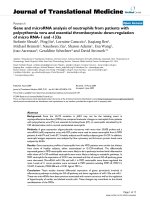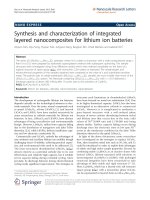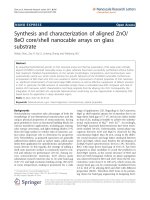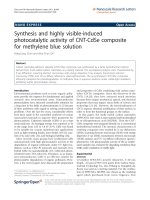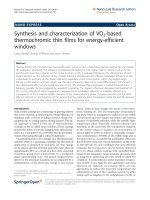Báo cáo hóa học: " Synthesis and magnetic properties of Zr doped ZnO Nanoparticles" docx
Bạn đang xem bản rút gọn của tài liệu. Xem và tải ngay bản đầy đủ của tài liệu tại đây (1.69 MB, 7 trang )
NANO EXPRESS Open Access
Synthesis and magnetic properties of Zr doped
ZnO Nanoparticles
Jing Zhang, Daqiang Gao, Guijin Yang, Jinlin Zhang, Zhenhua Shi, Zhaohui Zhang, Zhonghua Zhu and
Desheng Xue
*
Abstract
Zr doped ZnO nanoparticles are prepared by the sol-gel method with post-annealing. X-ray diffraction results show
that all samples are the ty pical hexagonal wurtzite structure without any other new phase, as well as the Zr atoms
have successfully entered into the ZnO lattices instead of forming other lattices. Magnetic measurements indicate
that all the doping samples show room temperature ferromagnetism and the pure ZnO is paramagneism. The
results of Raman and X-ray photoelectron spectroscopy indicate that there are a lot of oxygen vacancies in the
samples by doping element of Zr. It is considered that the observed ferromagnetism is related to the doping
induced oxygen vacancies.
Keywords: Zn
1-x
Zr
x
O nano particles, Room temper ature ferromagnetism, Oxygen vacancies
Introduction
Diluted magnetic semiconductors (DMSs) have attr acted
intense interest due to their potential applications in
spintronic devices [1-3]. DMSs are usually produced by
doping semiconductors with transition metals (TMs).
Through theoretically predicting, GaN and ZnO as typi-
cal n-type semiconductors would be ideal candidates for
room-temperature (RT) DMSs [4]. The room tempera-
ture ferromagnetism (RTFM) in TM-doped GaN has
been reported in experiment and theroy, such as, Mn
[5,6], Gd [7], and Cr [8,9]. Compared with GaN, ZnO
has a lot of outs tanding superiorities, as is known to all,
which has a wide band-gap (3.37 eV at RT) and a high
excitation binding energy ( 60 meV at RT), so ZnO has
been got more and more attention. Otherwise, since
Dietl et al. predicted that Mn-doped ZnO can show the
clear RTFM and also has a higher Curie temperature
(T
C
) than RT [10], which triggered worldwide interest in
research of the doping ZnO materials. At first, RTFM
has been demonstrated for various kinds of TM-doped
ZnO, for example, Mn [11], Co [12], Ni [13], and Fe
[14]. However, the origin of their magnetism remains
controversy, because it is n ot yet clear whether the
observed RTFM is truly intrinsic or related to secondary
phases such as clusters [13]. To avoid the impact from
ferromagnetic (FM) elements, in recent years, RTFM in
ZnO doping with other non-ferromagnetic elements has
been discovered in experiment and theory, for instance,
Cu [15,16], V [17], Cr [18,19], Li [20,21], C [22], Er
[23]-doped ZnO. However, until now there is no con-
sensusontheoriginofFMindopingZnO,sowe
researched the ori gin of RTFM in the doping ZnO
materials, it was hoped that we could get a better expla-
nation about this intractable issue.
Paul et al. prepared the Zr doped ZnO films using a
sol-gel technique with post-annealing successfully and
found the fil ms of ex tremely great properties, such as in
the structural, optical, a nd electrical aspects, otherwise,
at higher Zr concentrations, increasing dopant atom
forms some kinds of defects [24]. Defects may cause FM
to appear reported before [15,23] , so in this paper, we
prepared Zr doped ZnO nanoparticles (NPs) by the
same method and studied the structure and their mag-
netic property with the different Zr doping contents.
Experiment
Zn
1-x
Zr
x
O NPs were prepared by the sol-gel method
with post-annealing. All the chemical reagents used as
starting materials are analytic grade reagents and pur-
chased without any further treatment. Firstly, 0.1 M Zn
(NO
3
)
2
·6H
2
OandyM (y = 0.0005, 0 .001, 0.0015, and
* Correspondence:
Key Laboratory for Magnetism and Magnetic Materials of MOE, Lanzhou
University, Lanzhou 730000, PR China
Zhang et al. Nanoscale Research Letters 2011, 6:587
/>© 2011 Zhang et al; licensee Springer. This i s an Open Access article distributed under the terms of t he Crea tive Co mmons Attribution
License ( which pe rmits unrestricted use, distribution, and r eproduc tion in any medium,
provided the original work is properly cited.
0.002) Zr(NO
3
)
4
·5H
2
O were dissolved into the ethylene
glycol monomethylether (C
3
H
8
O
2
). Then, the dissolved
solutio n was stirred for 4 h at 80°C and dried at 80°C in
the oven to form the precursor. Finally, the precursor
was annealed at 500°C for 1.5 h in the air and the series
of Zn
1-x
Zr
x
O NPs were obtained. At the same time, Zr
contents of Zn
1-x
Zr
x
O samples are consistent with the
mole percentage (x = 0.005, 0.01, 0.015, and 0.02).
The morphologies of samples were characterized by
scanning electron microscope (SEM, Hitachi S-4800,
Hitachi High Technologies America, Inc., Schaumburg,
IL, USA) and transmission electron microscope (TEM,
JEM-2010, JEOL Ltd., Tokyo, Japan). Selected area elec-
tron diffraction (SAED) and x-ray diffraction (XRD, X’
Pert PRO PHILIPS with Cu Ka radiation, PANalytical,
Shanghai, P eople’s Republic of China) were employed to
study th e structure of the sa mples. The vibration prop-
erties were characterized by the Raman scattering spec-
tra measurement, which was performed on a Jobin-Yvon
LabRam HR80 spectrometer (Horiba Jobin Yvon Inc.,
Edison, NJ, USA) with a 325 nm line of Torus 50 mW
diode-pumped solid-state laser under backscattering
geometry. X-ray photoelectron spectroscopy (XPS, VG
ESCALAB 210, VG Scientific Ltd., East Grinstead, UK)
was utilized to determine the bonding characteristics
and the composition of the particles. The measurements
of magnetic properties were made using vibrating sam-
ple magnetometer (VSM, Lakeshore 7304, Lakeshore
Cryotronics, Inc., Westerville, OH, USA) and Quantum
Design MPMS magnetom eter based on superconducting
quantum interference device (SQUID).
Results and discussion
The XRD patterns of Zn
1-x
Zr
x
O samples (x = 0.005,
0.01, 0.015, 0.02) are shown in Figure 1(a). The results
indicate that all the samples are the typical hexagonal
wurtzite structure (J CPDS card no.36-1451). No phase
of Zr or its oxide is observed. Figure 1(b) shows an
observably slight shift towards the smaller angle with
enhancing of the Zr doping content x. And the lattice
parame ter a and c increase monotonously with the con-
tent × increasing (shown in Figure 1(c)) based on the
results of F igure 1(a). This reason may be that the ionic
radius of Zr
4+
(0.84 Å) is larger t han that o f Zn
2+
(0.74
Å) [25,26], the more Zn
2+
were substituted by Zr
4+
,the
greater lattice distortion of ZnO would be generated,
the more lat tice expansion would become. These results
indicate that the Zr atoms have successfully entered into
the ZnO lattices instead of forming other lattices.
Figure 2 shows the SEM images of Zn
1-x
Zr
x
O samples
(x = 0.005, 0.01, 0.015, 0.02). It is clearly seen that all
the Zn
1-x
Zr
x
O NPs are partly accumulated together with
different s izes, while many little NPs with the about 60
nm diameter make up a comparatively bigger NP.
Further, the size and shape of the NPs does not change
a lot as the content × of Zr doping enhances. The parti-
cle morphologies for the samples were also obtained b y
the TEM images, Figure 3(a) shows the representative
TEM image of Zn
0.995
Zr
0.005
ONPswhichalsoconfirms
that NPs are accumulated together and the diameter o f
the NPs is about 60 nm. The homologous SAED pattern
in the inset of Figure 3(a) shows discontinuous diffrac-
tion rings instead of shiny spots, which are attributed to
the hexagonal wurtzite structured ZnO crystal and indi-
cate that NPs are polycrystalline. It can be clearly seen
from the high-resoluti on elect ron microscopy (HRTEM)
image of Zn
0.995
Zr
0.005
O in Figure 3(b) that NPs are
well crystallized and the interplanar spacing as calcu-
lated from the HRTEM image is 0.28 nm, corresponding
to the lattice constant of the standard hexagonal wurt-
zite structured ZnO in (100) plane.
The chemical states of the compositional elements in
Zn
1-x
Zr
x
O NPs were revealed by the XPS and the repre-
sentative spectra of Zn
0.995
Zr
0.005
OareshowninFigure
4. In Figure 4(a), the survey spectrum, the indexed
peaks are only correspond to elements Zn, O, Zr, and
C, where the binding energies are calibrated by taking
carbon C 1s peak (284.6 eV). The peak located at 1 83
and 185 eV is identified with the binding energy of Zr
3d
5/2
and 3d
3/2
respectively, shown in Figure 3(c), corre-
sponding to the peaks of Zr
4+
ions [27]. The result of
Zn 2p co re-level XPS spectrum for ZnO (Figure 3(b))
shows that the doublet spectral lines of Zn 2p are
observed at the binding energy of 1022 eV (Zn 2p
3/2
)
and 1045 eV (Zn 2p
1/2
) with a spin-orbit splitting of 23
eV, which coincides with the results for Zn
2+
in ZnO
[28]. It is important and inter esting that the peak in the
O1s spectrum ( Figure 4(d)) is not totally symmetrical.
As reported before, the O 1s peak can be fitted by three
Gaussion peaks with different binding energy compo-
nents [29]. The dominant peak located at 530.1 ± 0.2
eV (Oa) is assigned to O
2-
ions in the ZnO hexagonal
wurtzite structure. The medium binding energy compo-
nent at the peak o f 531.2 ± 0.2 eV (Ob) i s attributed to
lost O
2-
ions in oxygen deficient regions (oxygen vacan-
cies) within the matrix of ZnO. The highest binding
energy compo nent at the peak of 532.4 ± 0.2 eV (Oc) is
usually ascribed to nons toichiometric near-surface oxy-
gen, oxygen atoms in carbonate ions (whi ch are dis-
posed on surfaces of ZnO), surface hydroxylation,
adsorbed H
2
O, or adsorbed O
2
. Ob owing to oxygen
vacancies, whose area ratio is 22.17%, should be noticed
in the above three parts, so we assume that there are a
lot of the oxygen vacancies in Zn
0.995
Zr
0.005
O NPs.
The additional information Zn
1-x
Zr
x
ONPswas
obtained by Raman spectroscopy. Figure 5 shows the
RT Raman spectra of the samples at the range of 100-
800 c m
-1
. T he sole and obvious peak located at around
Zhang et al. Nanoscale Research Letters 2011, 6:587
/>Page 2 of 7
574 cm
-1
is owi ng to the A
1
(LO) phonon mo de, which
is associated with the d efects of oxygen vacancies, Zn-
interstitials or their complex [30]. Further, the sole peak
from Raman spectra along with the above O 1s peak in
XPS spectra may be the presence of oxygen vacancies in
Zr-doped ZnO lattice.
The XPS and Raman spectra show there are ma ny
oxygen vacancies in samples, o xygen vacancies may
cause the RTFM to appear reported before [31,32]. As
the result, those motivated us to carry out a comparative
study on their magnetic properties. Magnetization
curves as a function of applied magnetic field (M-H)at
RT of samples are revealed in Figure 6, where the con-
tributions of the paramagnetism (PM) signals of the
samples were deducted. In the inset of Figure 6, which
displays the M-H curves of the pure ZnO NPs at RT,
the pure ZnO NPs show a PM behavior. M eanwhile it
can be seen that the other doping samples exhibit
Figure 1 XRD patterns repre sented by lines o f different col ors.(a) XRD patterns of Zn
1-x
Zr
x
Osamples;(b)XRDpatternsofZn
1-x
Zr
x
O
samples in detail; (c) the variation of the lattice parameter a and c dependent on the Zr content in samples (x = 0.005, 0.01, 0.015, 0.02).
Figure 2 SEM images of ZnO NPs with different Zr contents.
Zhang et al. Nanoscale Research Letters 2011, 6:587
/>Page 3 of 7
hysteresis curves with the different saturation magneti-
zation (M
s
), which indicates that all the doping samples
have the clear RTFM. It’ s sure that the RTFM is
induced by doping of Zr. Furthermore, the magnetism
of the samples depends strongly on the doping Zr con-
tent, and M
s
per Zr atom decreases monotonously from
0.0089 μ
B
/Zr (Zn
0.995
Zr
0.005
O) to 0.0013 μ
B
/Zr
(Zn
0.98
Zr
0.02
O) as the increase of the doping content.
Figure 3 TEM and HRTEM images of Zn
0.995
Zr
0.005
ONps.(a) The representative TEM image of Zn
0.995
Zr
0.005
O and the inset is the SAED
pattern. (b) The HRTEM image of Zn
0.995
Zr
0.005
O.
Figure 4 XPS spectra represented by lines of different colors. (a) XPS survey spectrum, high resolution scan of (b) Zn 2p, (c) Zr 3d, and (d) O
1s of Zn
0.995
Zr
0.005
O Nps.
Zhang et al. Nanoscale Research Letters 2011, 6:587
/>Page 4 of 7
In order to further confirm that there is not any con-
tamination of ferromagnetic cluster formation and the
observed FM is the instinct property of Zn
1-x
Zr
x
ONPs,
the zero-field-cooled (ZF C) and field-cooled (FC) mag-
netization curves at the dc field of 100 Oe in the tem-
perature range of 10 to 300 K are measured on these
samples, it’s given the typical one of Zn
0.995
Zr
0.005
O NPs
bec ause of its largest M
s
(Figure 7a), which is suggested
that there is no blocking temperature. What’smore,
there is no other FM ele ment (such as Fe, Co) through
the XPS with very high precision, because of the above
ZFC and FC magnetization curves, the ferromagnetic
contamination can be excluded, in other words, the
observed RTFM of Zn
1-x
Zr
x
O N Ps should be the intrin-
sic nature. Furthermore, the FC curve exhibits an
obvious deviation from the ZFC curve until the
temperature above 300 K, indicating that the T
C
of the
sample is w ell above 300 K. The result of the ZFC and
FC curves suggests the sample has the clear RTFM,
which is as the same as the results from VSM.
In other element-doping systems, different mechan-
isms of FM have been reported. Hou et al. reported that
the carrier-induced FM (RKKY or double exchange
mechanism) might be applied to explain the FM in Cu-
doped ZnO films, in which the free carrier concentra-
tion is vital to determine whether the material is PM or
FM [33]. Meanwhile, Hu et al. found that Cr ion substi-
tution is necessary for establishing FM in Cr-doped
ZnO films containing V
Zn
[34]. However, Ran et al. sug-
gested that defects of Cu-doped ZnO films, such as oxy-
gen vacancies and/or zinc interstitials, might contrib ute
to the RTFM, thus, the observed RTFM was explained
Figure 5 Raman spectra represented by lines of different colorsof Zn
1-x
Zr
x
O NPs (x = 0.005, 0.01, 0.015, 0.02).
Figure 6 M-H curves represented by lines of different colors.
M-H curves of Zn
1-x
Zr
x
O NPs (x = 0.005, 0.01, 0.015, 0.02) at RT. The
inset is the M-H curve of pure ZnO NPs at RT.
Figure 7 FC-ZFC curve of Zn
0.995
Zr
0.005
ONpsinthelow
temperature range of 10-300 K.
Zhang et al. Nanoscale Research Letters 2011, 6:587
/>Page 5 of 7
in terms of defect-related models [35]. Otherwise, Qi et
al. concluded that an exchange mec hanism associated
with oxygen vacancies was responsible for the FM in the
Zn
1-x
Er
x
O thin films [23]. At the same time, the RTFM
was clearly observed in In-doped ZnO nanowires, which
may be associated with oxygen vacancies induced by In
doping [36]. In our system, the pure ZnO NPs show the
PM behavior, but all of the other doping samples exhibit
the clear RTFM, s o it’s sure that the RTFM is induced
by doping of Zr. In the XRD patterns, all the intense
peaks from Zn
1-x
Zr
x
O (x = 0.005, 0.01, 0.015, 0.02)
coul d be i ndexed the same hexagonal wurtzite structure
as pure ZnO NPs, the increase in a and c parameter as
a function of Zr concentration is consistent with the
substitution of Zn
2+
ions (0.74 Å) by Zr
4+
ions (0.84 Å)
[25,26]. The more Zn
2+
were substituted by Zr
4+
,the
greater lattice distortion of ZnO would be generated,
the more vacancies and/or interstitials should be got.
After measured the Raman and XPS, our supposition
has been affirmed that there are lots of oxygen vacancies
in our samples. As a result, oxygen vacancies should be
considered as the origin of FM in our samples, which
seems to be similar to the series of Er [23], In [36]-
doped ZnO, where the oxygen vacancies also play a cru-
cial role in the RTFM.
Conclusions
We successfully prepared Zn
1-x
Zr
x
O NPs with the typi-
cal pure ZnO hexagonal wurtzite structure by the sol-
gel method with post-annealing. All the samples have
the clear RTFM, and M
s
per Zr atom of samples is sen-
sitive to the content of Zr, and decreases continuously
as the i ncrease of the doping Zr content through the
magnetic measurement at RT. Combining with the
results of Raman and XPS, we suppose that the FM of
the Zn
1-x
Zr
x
O NPs is owing to t he oxygen vacancies
inducing by doping of the nonmagnetic element of Zr.
Acknowledgements
This work is supported by National Science Fund for Distinguished Young
Scholars (Grant No. 50925103 and 11034004), the Keygrant Project of
Chinese Minisity of Education (Grant No. 309027), and NSFC (Grant
No.50902065).
Authors’ contributions
JZ prepared the samples, participated in all of the measurements and data
analysis, and drafted the manuscript. DG and DX made the conception and
design of the manuscript. ZZ2 carried out the XPS measurements and data
analysis. JLZ and ZZ1 participated in the XRD measurements and data
analysis. GY and ZS participated in the data analysis and the interpretation
of the results. All authors have been involved in revising the manuscript,
read and approved the final manuscript.
Competing interests
The authors declare that they have no competing interests.
Received: 1 June 2011 Accepted: 10 November 2011
Published: 10 November 2011
References
1. Dietl T, Ohno H: Ferromagnetic III-V and II-VI Semiconductors. Mrs Bull
2003, 28:714.
2. Hong NH, Sakai J, Huong NT, Poirot N, Ruyter A: Role of defects in tuning
ferromagnetism in diluted magnetic oxide thin films. Phys Rev B 2005,
72:045336.
3. Liu H, Zhang X, Li LY, Wang YX, Gao KH, Li ZQ, Zheng RK, Ringer SP,
Zhang B, Zhang XX: Role of point defects in room-temperature
ferromagnetism of Cr-doped ZnO. Appl Phys Lett 2007, 91:072511.
4. Dietl T: Ferromagnetic semiconductors. Semicond Sci Technol 2002, 17 :377.
5. Chambers SA: Ferromagnetism in doped thin-film oxide and nitride
semiconductors and dielectrics. Surf Sci Rep 2006, 61:345.
6. Aoki M, Yamane H, Shimada M, Kajiwara T: Single crystal growth of
manganese gallium nitride using Mn-Ga-Na melt. J Alloy Compd 2004,
364:280.
7. Litvinov VI, Dugaev VK: Room-temperature ferromagnetism in dielectric
GaN(Gd). Appl Phys Lett 2009, 94:212506.
8. Cui XY, Medvedeva JE, Delley B, Freeman AJ, Newman N, Stampfl C: Role of
Embedded Clustering in Dilute Magnetic Semiconductors: Cr Doped
GaN. Phys Rev Lett 2005, 95:256404.
9. Wang Q, Sun Q, Jena P, Kawazoe Y: Ferromagnetic to ferrimagnetic
crossover in Cr-doped GaN nanohole arrays. Phys Rev B 2007, 75:075312.
10. Dietl T, Ohno H, Matsukura F, Cibert J, Ferrand D: Zener Model Description
of Ferromagnetism in Zinc-Blende Magnetic Semiconductors. Science
2000, 287:1019.
11. Yang T, Li Y, Zhu MY, Li YB, Huang J, Jin HM, Hu YM: Room-temperature
ferromagnetic Mn-doped ZnO nanocrystal synthesized by hydrothermal
method under high magnetic field. Mater Sci Eng B 2010, 170:129.
12. Chaudhary S, Bhatti KP, Pandya DK, Kashyap SC, Nigam AK: Effect of
indium incorporation in Zn
1-x
Co
x
O thin films. J Magn Magn Mater 2009,
321:966.
13. Tong LN, He XM, Han HB, Hu JL, Xia AL, Tong Y: Effects of H
2
annealing
on ferromagnetism of Ni-doped ZnO powders. Solid State Commun 2010,
150:1112.
14. Hong NH, Sakai J, Brize V: Observation of ferromagnetism at room
temperature in ZnO thin films. J Phys: Condens Matter 2007, 19:036219.
15. Gao DQ, Xue DS, Xu Y, Yan ZJ, Zhang ZH: Synthesis and magnetic
properties of Cu-doped ZnO nanowire arrays. Electrochim Acta 2009,
54:2392.
16. Kim CO, Kim S, Oh HT, Choi SH, Shon Y, Lee S, Hwang HN, Hwang CC:
Effect of electrical conduction properties on magnetic behaviors of Cu-
doped ZnO thin films. Physica B 2010, 405:4678.
17. Wang Q, Sun Q, Jena P, Hu Z, Note R, Kawazoe Y: First-principles study of
magnetic properties in V-doped ZnO. Appl Phys Lett 2007, 91:063116.
18. Shi HL, Duan YF: First-Principles Study of Magnetic Properties of 3d
Transition Metals Doped in ZnO Nanowires. Nanoscale Res Lett 2009,
4:480.
19. Zhuge LJ, Wu XM, Wu ZF, Chen XM, Meng YD: Effect of defects on room-
temperature ferromagnetism of Cr-doped ZnO films. Scrirta Mater 2009,
60:214.
20. Chawla S, Jayanthi K, Kotnala RK: Room-temperature ferromagnetism in
Li-doped p-type luminescent ZnO nanorods. Phys Rev B 2009, 79:125204.
21. Meyer BK, Hofstaetter A, Laguta VV: Tunneling phenomena of trapped
holes in ZnO: Li. Physica B 2006, 376:682.
22. Pan H, Yi JB, Shen L, Wu RQ, Yang JH, Lin JY, Feng YP, Ding J, Van LH,
Yin JH: Room-Temperature Ferromagnetism in Carbon-Doped ZnO. Phys
Rev Lett 2007, 99:127201.
23. Qi J, Yang YH, Zhang L, Chi JH, Gao DQ, Xue DS: Room-temperature
ferromagnetism in Er-doped ZnO thin films. Scrirta Mater 2009, 60:289.
24. Paul GK, Bandyopadhyay S, Sen SK, Sen S: Structural, optical and electrical
studies on sol-gel deposited Zr doped ZnO films. Mater Chem Phys 2003,
79(71).
25. Mezdrogina MM, Danilevskii EY, Kuz’min RV, Poletaev NK, Trapeznikova IN,
Chukichev MV, Bordovskii GA, Marchenko AV, Eremenko MV: The effect of
Fe, Cu, and Si impurities on the formation of emission spectra in bulk
ZnO crystals. Semiconductors 2010, 44:426.
26. Fornasiero P, Monte RD, Rao GR, Kaspar J, Meriani S, Trovaralli A, Graziani M:
Rh-Loaded CeO
2
-ZrO
2
Solid Solutions as Highly Efficient Oxygen
Exchangers: Dependence of the Reduction Behavior and the Oxygen
Storage Capacity on the Structural Properties. Journal of Catalysis 1995,
151:168.
Zhang et al. Nanoscale Research Letters 2011, 6:587
/>Page 6 of 7
27. Reddy BM, Chowdhury B, Reddy EP, Fernandez A: Characterization of
MoO
3
/TiO
2
-ZrO
2
catalysts by XPS and other techniques. J Mol Catal A
2000, 162:431.
28. Wei XQ, Man BY, Liu M, Xue CS, Zhuang HZ, Yang C: Blue luminescent
centers and microstructural evaluation by XPS and Raman in ZnO thin
films annealed in vacuum, N
2
and O
2
. Physica B 2007, 388:145.
29. Chen M, Wang X, Yu YH, Pei ZL, Bai XD, Sun C, Huang RF, Wen LS: X-ray
photoelectron spectroscopy and auger electron spectroscopy studies of
Al-doped ZnO films. Appl Surf Sci 2000, 158:134.
30. Pradhan AK, Zhang K, Loutts GB, Roy UN, Cui Y, Burger A: Structural and
spectroscopic characteristics of ZnO and ZnO:Er
3+
nanostructures. J Phys:
Condens Matter 2004, 16:7123.
31. Coey JMD, Venkatesan M, Fitzgerald CB: Donor impurity band exchange in
dilute ferromagnetic oxides. Nat Mater 2005, 4:173.
32. Herng TS, Qi DC, Berlijn T, Yi JB, Yang KS, Dai Y, Feng YP, Santoso I,
Sanchez-Hanke C, Gao XY, Wee ATS, Ku W, Ding J, Rusydi A: Room-
Temperature Ferromagnetism of Cu-Doped ZnO Films Probed by Soft X-
Ray Magnetic Circular Dichroism. Phys Rev Lett 2010, 105:207201.
33. Hou DL, Ye XJ, Zhao XY, Meng HJ, Zhou HJ, Li XL, Zhen CM: Room-
temperature ferromagnetism in n-type Cu-doped ZnO thin films. J Appl
Phys 2007, 102:033905.
34. Hu YM, Hsu CW, Wang CY, Lee SS, Wang SJ, Han TC, Chou WY: Room-
temperature ferromagnetism in co-sputtered Zn
1-x
Cr
x
O films with low Cr
content. Scrirta Mater 2009, 61:1028.
35. Ran FY, Tanemura M, Hayashi Y, Hihara T: Effect of substrate temperature
on the room-temperature ferromagnetism of Cu-doped ZnO films. J
Cryst Growth 2009, 311:4270.
36. Liu KW, Sakurai M, Aono M: Indium-doped ZnO nanowires: Optical
properties and room-temperature ferromagnetism. J Appl Phys 2010,
108:043516.
doi:10.1186/1556-276X-6-587
Cite this article as: Zhang et al.: Synthesis and magnetic properties of
Zr doped ZnO Nanoparticles. Nanoscale Research Letters 2011 6:587.
Submit your manuscript to a
journal and benefi t from:
7 Convenient online submission
7 Rigorous peer review
7 Immediate publication on acceptance
7 Open access: articles freely available online
7 High visibility within the fi eld
7 Retaining the copyright to your article
Submit your next manuscript at 7 springeropen.com
Zhang et al. Nanoscale Research Letters 2011, 6:587
/>Page 7 of 7
